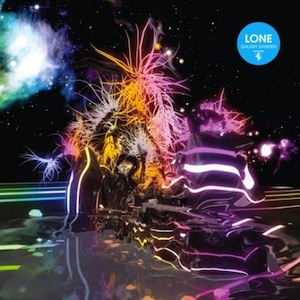Lone Galaxy Garden
“I wanted everything to be as colourful as possible,” said Lone (a.k.a. Matt Cutler) in […]

“I wanted everything to be as colourful as possible,” said Lone (a.k.a. Matt Cutler) in a recent interview with XLR8R regarding Galaxy Garden, his latest full-length. That kind of statement seems a bit redundant coming from Cutler, as the Emerald Fantasy Tracks producer has already made a name for himself by marrying the best of early-’90s strobelight-rave tropes with the synesthesia-inducing textures of Boards of Canada. On top of that, “Crystal Caverns 1991,” the lead single off Galaxy Garden that dropped a few months back, appeared to be right in line with Lone’s recent work. This context made it hard to expect any kind of step forward from the Nottingham producer, even on his first LP since 2010.
Regardless, it’s hard to argue with this album, even while much of it is unapologetic in drawing from Lone’s time-tested arsenal of tricks. Fans of the detuned synths on Emerald’s “Re-Schooling” will enjoy “The Animal Pattern,” which finds Lone mashing keys on a similar synth preset, adding an acid bassline, and ultimately creating what is perhaps the best realization yet of his now-trademark sound. The same goes for album opener “New Colour,” which recalls the emotive whinny of Echolocations‘ “Blossom Quarter,” but actually does it one better, saturating the track with ethereal melodies just short of collapsing into trance.
There are, however, a few instances when Lone seemingly does make a concerted effort to take his sound in new directions. The most obvious are his two vocal tracks, “As a Child” and the closing “Spirals,” featuring Machinedrum and Anneka, respectively. Lone embellishes both with familiar synth washes and Latin percussion, but the bite is gone, replaced instead by the indifferent croons of either vocalist. Lone has cited the footwork rhythms of Machinedrum’s Room(s) as an influence on “As a Child,” but the raw energy of that album is hard to find here. Both of these tracks feel flat, and the loungey vocal performances certainly compound that sensation.
Cutler fares better with his other experiments on the album. He plays with new tempos well—the two-part “Dream Girl/Sky Surfer” starts with a traditional Lone blueprint, but disintegrates into a gorgeous, downtempo outro. The H.P. Lovecraft-alluding “Cthulhu” works drum & bass bpms while playing with a swirling string counterpoint. On “Earth’s Lungs,” FM-filtered bells are suffocated in funky bass, imprinting a rough texture above the producer’s angular melodies. Lone has already pushed the limits of house nostalgia, but here, the producer is finding new and successful ways to imbue his tracks with sentimentality.
Since the appearance of “Pineapple Crush” in 2010, the quality of Lone’s work has been particularly high. And while some others at the forefront of the ’90s rave renaissance (read: Zomby) have moved on, Cutler continues to hone the sound. Galaxy Garden is a fine effort, an album that tweaks Lone’s formula just enough to pass as a step forward.

